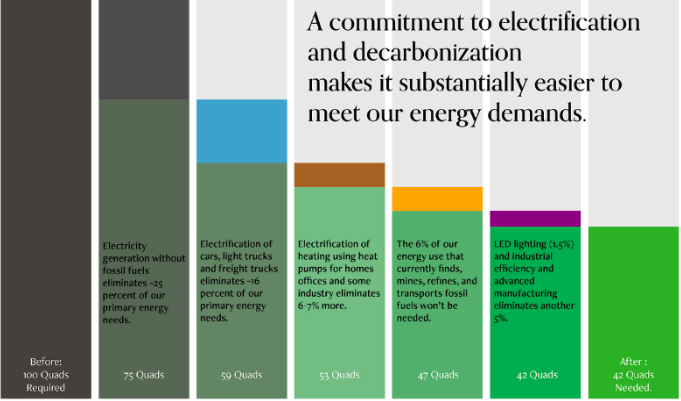
In 2017, the advanced research arm of the Energy Department (Advanced Research Project Agency of the Department of Energy or ARPA-e) hired the engineering firm Otherlab to review all available energy data sources and create an ultra-high resolution picture of the US energy economy. What they found, as described in a recent article by the lead engineer in Medium, is highly promising — contrary to popular belief, decarbonization is not an unattainable ideal but is possible if we switch energy generation technologies. They found that “without changing the size of our homes, or our cars, or fundamentally changing the fabric of our lives, these discounts [from greater efficiencies] mean that a fully electrified energy economy using non-carbon fuel sources would require less than half of the total amount of energy we use today.”
How is this possible? Here is how the savings add up — or down:
- 100 Quads of Energy: Energy use at the scale of the national economy is measured in quads. One quad is 1 quadrillion British Thermal Units (BTU’s)³. Conveniently, the US uses about 100 quads each year, meaning that one quad is roughly equal to 1% of the US’s total national annual energy use.
- Power Generation: Of the 39 quads of primary energy going into the electricity sector, only about 12 are actually delivered to industry, our homes, and our businesses. The rest disappears, quite literally, into the air as waste heat and carbon dioxide.
- Transportation: If we electrify all cars and trucks, we will reduce by about ⅔ the amount of energy consumed in moving those vehicles – of the 21 quads we currently require for road and highway transportation, we’ll only need about 7.
- Fossil Fuel Development: Not needing to find, mine, refine and transport fossil fuel saves another 6 quads — we will have to build wind and solar generating capacity, and electric cars too, but these will fuel a new clean power economy and pay for themselves in cost savings.
- Home and Office Building Heat: Switching to electric heat for homes and office buildings will save another 5 to 7 Quads — that means cooking, hot water, clothes drying, etc. all done with electric energy from renewable sources.
- Lighting: Switching to LED bulbs and energy-efficient lighting can save another 5 Quads.
You might wonder (given the President’s flip comments about the reliability of wind power over the weekend) if it is possible to electrify everything? What about airplanes, for example, that don’t run on wind or solar? The authors estimate that we will need to double the amount of energy generated from biofuels from 4.5 Quads to about 9, but they argue that this is achievable with investment, given the giant potential of U.S. biofuels.
Why This Matters: For everyone who says the Green New Deal is not feasible (like Senator Feinstein), we say think again. This study may need further analysis, but we know that the system we have now is inefficient and expensive. And we have not even added in the “cost” of pollution from fossil fuels in terms of health care and lost productivity. Fuel switching is not cheap, but it can pay for itself through savings — just look at the boom in efficiency that is already happening in the energy sector. This is what is behind the switch to solar and wind and LED bulbs and energy efficient factories and buildings already — before the enormous boost a Green New Deal of government incentives and investment could provide. The authors of the study point out that the energy technologies they describe have high-capital costs but low operating costs, which in their view makes them great opportunities for financing innovation — the kind of innovation we have seen in the past with home mortgages and auto loans that changed American society. We just have to think beyond our current fossil fuel conventions!

March 5, 2019 » decarbonization, energy efficiency, fossil fuel, Green New Deal, solar energy, wind power


